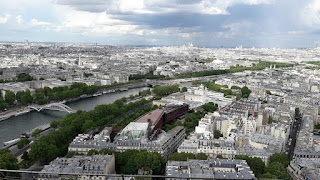“He who contemplates the depths of Paris .
The large airport, the serene atmosphere, the cool breeze after a fresh drizzle of rain, and the ambience transported one to the present, far away from the Greek Mythology.
Every place in this rich city worked
on sensors. The lights operated when they sensed a human presence, water gushed
out as soon as the taps sensed the presence, and the evening sky also seemed to
welcome us with a fresh spurt of rain sensing our charisma as we walked out of
the airport into the city.
We were introduced to the driver of the Coach, Mr. Roland and ushered into his clean and well maintained luxury coach. Mr. Roland looked young and was in good physique, one had to peer into the lines of his face to know his actual age. He was formally dressed and looked like an executive, but his work involved great precision and perfection. He opened the coach storage and arranged our luggage in an orderly approach. We saw the young, the elderly, and the middle-aged were all self sufficient. Perhaps the unavailability of help or the dignity of
The next morning we began our tour from the Arc de Triomphe, which was built to
At the Eiffel Tower Paris
as it rose above the floors of the tower. They admired the city, waved hands,
hugged each other for having travelled so far and lived their life robustly. It
was thankfulness for their existence in the prized present. The top floor was
the coolest, but the feelings were the warmest. The tower has a lot of space,
telescope at various spots to view the city, and rickety stairs for those who
love climbing the stairs.
One wonders how this huge lanky
structure could evoke love. The whole structure is made up of three shades of
the metal Iron and the structure has around 18000 pieces of Iron. This envisage
by Gustave Eiffel became a hope, an assurance and a legacy
of France .
It bonded the people in many ways, the oneness of the people made it unique and
it became a symbol of adulation. There is a huge lawn and a well designed ground
on one side of the tower where lakhs of people could stroll, rest, jog and
cycle for you find the healthiest lot of people here who are conscious about
their well being. The citizens run along the river, cycle on the shore, sit
with friends on the green grassy patches, making one reminisce the good old days
when people socialized
We were ushered for a cruise on the river Seine mesmerised the n th time
Everyone wanted to visit the Opera House or the busy streets, but we saw the lights being switched off and darknessplunge
Everyone wanted to visit the Opera House or the busy streets, but we saw the lights being switched off and darkness







Comments
Post a Comment